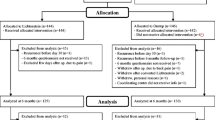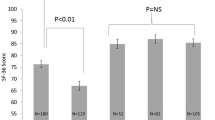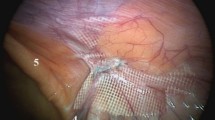Abstract
Background
Traditional methods of clinical research may not be adequate to improve the value of care for patients with complex medical problems such as chronic pain after inguinal hernia repair. This problem is very complex with many potential factors contributing to the development of this complication.
Methods
We have implemented a clinical quality improvement (CQI) effort in an attempt to better measure and improve outcomes for patients suffering with chronic groin pain (inguinodynia) after inguinal hernia repair. Between April 2011 and June 2016, there were 93 patients who underwent 94 operations in an attempt to relieve pain (1 patient had two separate unilateral procedures). Patients who had prior laparoscopic inguinal hernia repair (26) had their procedure completed laparoscopically. Patients who had open inguinal hernia repair (68) had a combination of a laparoscopic and open procedure in an attempt to relieve pain. Initiatives to attempt to improve measurement and outcomes during this period included the administration of pre-operative bilateral transversus abdominis plane and intra-operative inguinal nerve blocks using long-acting local anesthetic as a part of a multimodal regimen, the introduction of a low pressure pneumoperitoneum system, and the expansion of a pre-operative questionnaire to assess emotional health pre-operatively.
Results
The results included the assessment of how much improvement was achieved after recovery from the operation. Forty-five patients (48%) reported significant improvement, 39 patients (41%) reported moderate improvement, and 10 patients (11%) reported little or no improvement. There were 3 (3%) complications, 13 (11%) hernia recurrences, and 15 patients (13%) developed a new pain in the inguinal region after the initial pain had resolved.
Conclusions
The principles of CQI can be applied to a group of patients suffering from chronic pain after inguinal hernia repair. Based on these results additional process improvement ideas will be implemented in an attempt to improve outcomes.


Similar content being viewed by others
References
Aasvang E, Kehlet H (2005) Chronic postoperative pain: the case of inguinal herniorrhaphy. Br J Anaesth 95:69–76
Nienhuijs S, Staal E, Strobbe L, Rosman C, Groenewoud H, Bleichrodt R (2007) Chronic pain after mesh repair of inguinal hernia: a systematic review. Am J Surg 194:394–400
Franneby U, Sandblom G, Nordin P, Nyren O, Gunnarsson U (2006) Risk factors for long-term pain after hernia surgery. Ann Surg 244:212–219
Ferzli GS, Edwards E, Al-Khoury G, Hardin R (2008) Postherniorrhaphy groin pain and how to avoid it. Surg Clin N Am 88:203–209
Kehlet H (2008) Chronic pain after groin hernia repair. Br J Surg 95:135–136
van der Pool AEM, Harlaar JJ, den Hoad PT, Weidema WF, van Veen RN (2010) Long-term follow-up evaluation of chronic pain after endoscopic total extraperitoneal repair of primary and recurrent inguinal hernia. Surg Endosc 24:1707–1711
Macintyre PE, Schug SA, Scott DA, Visser EJ, Walker SM, APM:SE Working Group of the Australian and New Zealand College of Anaesthetists and Faculty of Pain Medicine (2010) Acute pain management: scientific evidence, 3rd edn. Australian and New Zealand College of Anaesthetists and Faculty of Pain Medicine, Melbourne
Bittner R, Bingener-Casey J, Dietz U et al (2014) Guidelines for laparoscopic treatment of ventral and incisional abdominal wall hernias (International Endohernia Society (IEHS)—Part 1. Surg Endosc 28:2–29. doi:10.1007/s00464-013-3170-6
Kaplan RS, Porter ME (2011) The big idea: how to solve the cost crisis in health care. Harv Bus Rev September 2011. https://hbr.org/2011/09/how-to-solve-the-cost-crisis-in-health-care. Accessed 20 Jan 2015
Porter ME, Lee TH (2013) The strategy that will fix health care. Harv Bus Rev October 2013. https://hbr.org/2013/10/the-strategy-that-will-fix-health-care/. Accessed 20 Jan 2015
Zimmerman B, Lindberg C, Plsek P (1998) Edgeware: insights from complexity science for health care leaders. VHA, Inc., Irving
https://www.hhs.gov/ohrp/regulations-and-policy/guidance/faq/quality-improvement-activities/
Cunningham L, Ramshaw BJ (2016) Mesh removal for chronic pain. A review of laparoscopic and open techniques. In: Jacob B, Chen D, Towfigh S, Ramshaw B (eds) The SAGES manual of groin pain. Springer, New York, pp 301–317
Moreno-Egea A (2016) Surgical management of postoperative chronic inguinodynia by laparoscopic transabdominal preperitoneal approach. Surg Endosc 30:5222–5227
Chen DC, Hiatt JR, Amid PK (2013) Operative management of refractory neuropathic inguinodynia by a laparoscopic retroperitoneal approach. JAMA Surg 148(10):962–967
Wong J, Anvari M (2001) Treatment of inguinodynia after laparoscopic herniorrhaphy. Surg Laparosc Endosc Percutan Tech 11(2):148–151
Kehlet H, Jensen TS, Wolff CJ (2006) Persistent postsurgical pain: risk factors and prevention. Lancet 367:1618–1625
Nienhuijs SW, Rosman C, Strobbe LJA, Wolff A, Bleichrodt RP (2008) An overview of the features influencing pain after inguinal hernia repair. Int J Surg 6:351–356
Author information
Authors and Affiliations
Corresponding author
Ethics declarations
Disclosures
Bruce Ramshaw has received honoraria and/or consulting fees for providing speaking and/or advisory services for WL Gore, Medtronic, Ethicon, Pacira, Acelity, B Braun, Atrium, BG Medical ConMed, and Ariste Medical. He is also Founder and a Shareholder in CQInsights, a healthcare data analytics company. Brandie Forman is a Founder and Shareholder in CQInsights. Matthew Mancini has received honoraria for providing speaking services from Olympus, Medtronic, WL Gore, Pacira, and Mallinckrodt. Eric Heidel has received consulting fees for consulting services from CQInsights. Vincent Vetrano and Mayuri Jagadish have no conflicts of interest or financial ties to disclose.
Rights and permissions
About this article
Cite this article
Ramshaw, B., Vetrano, V., Jagadish, M. et al. Laparoscopic approach for the treatment of chronic groin pain after inguinal hernia repair. Surg Endosc 31, 5267–5274 (2017). https://doi.org/10.1007/s00464-017-5600-3
Received:
Accepted:
Published:
Issue Date:
DOI: https://doi.org/10.1007/s00464-017-5600-3




